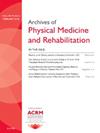微电解联合运动与单独运动对慢性肩袖肌腱病患者疼痛强度和残疾的疗效对比:随机临床试验。
IF 3.6
2区 医学
Q1 REHABILITATION
Archives of physical medicine and rehabilitation
Pub Date : 2025-06-01
DOI:10.1016/j.apmr.2024.10.016
引用次数: 0
摘要
研究目的比较组织内经皮微电解术(IPM)与肩部锻炼计划对肩袖肌腱病患者疼痛强度和残疾程度的影响:研究设计:双臂平行、单盲优效随机对照临床试验。研究地点:门诊部(阿尔卡特门诊(阿尔西德斯-卡内罗大学医院) 参与者:42 名肩袖肌腱病患者被随机分配(1:1)为 2 组:干预措施:干预措施:两组均接受由理疗师实施的治疗性锻炼计划(6 次上门课程),但只有 IPM+Ex 组接受了 IPM 的额外治疗(6 次课程)。采用线性混合模型对各组进行比较:主要结果测量:疼痛强度用数字疼痛评定量表(NPRS)测量,肩部残疾用肩部疼痛和残疾指数(SPADI)测量。次要结果:不良反应、每周在家锻炼的频率和总体效果:结果:40 人完成了为期 8 周的随访。IPM+Ex和Ex在疼痛方面的组内变化具有统计学意义(IPM+Ex:平均差异为-3.19;95% CI:-4.45至-1.94;Ex:平均差异为-3.99;95% CI:-1.94):-3.99;95% CI:-5.27 至 -2.72)和残疾(IPM+Ex:平均差异 -35.76;95% CI:-47.77 至 -23.76;Ex:平均差异:-38.26;95% CI:-50.45 至 -26.07)。我们发现,组间疼痛(平均差异:-1.23;95% CI:-2.54,0.07)或残疾(平均差异:7.17;95% CI:-7.02,21.35)均无显著差异。我们发现,在不良反应、每周家庭锻炼的频率和总体效果感知方面,组间没有差异(P < 0.05):结论:在进行治疗性锻炼的同时应用 IPM 不会对肩袖肌腱病患者的疼痛强度和残疾程度产生额外的影响。本文章由计算机程序翻译,如有差异,请以英文原文为准。
Effectiveness of Microelectrolysis Associated With Exercises Versus Exercises Alone on Pain Intensity and Disability in Individuals With Chronic Rotator Cuff Tendinopathy: A Randomized Controlled Trial
Objective
To compare the effectiveness of intratissue percutaneous microelectrolysis (IPM) in addition to shoulder exercise program on pain intensity and disability in individuals with rotator cuff tendinopathy.
Study Design
Two parallel arms, single-blind superiority randomized controlled trial.
Site
Outpatient clinic (Alcides Carneiro University Hospital).
Participants
Forty-two individuals with rotator cuff tendinopathy were randomly allocated (1:1) into 2 groups: IPM associated with exercises (IPM+Ex) and exercises only (Ex).
Interventions
Both groups underwent a therapeutic exercise program (6 in-person sessions) conducted by a physiotherapist, but only the IPM+Ex group received additional treatment with IPM (6 sessions). Linear mixed models were used to compare groups.
Main Outcome Measures
Pain intensity was measured with the Numerical Pain Rating Scale and shoulder disability with the Shoulder Pain and Disability Index. The outcomes were evaluated (blinded assessor) at baseline and 8 weeks after the intervention protocol. The secondary outcomes included adverse effects, frequency of the weekly home exercises, and overall perceived effect.
Results
Forty individuals completed the 8-week follow-up. There were statistically significant within-group changes in both IPM+Ex and Ex for pain (IPM+Ex: mean difference −3.19; 95% CI: −4.45 to −1.94; Ex: mean difference: −3.99; 95% CI: −5.27 to −2.72) and disability (IPM+Ex: mean difference −35.76; 95% CI: −47.77 to −23.76; Ex: mean difference: −38.26; 95% CI: −50.45 to −26.07). We found no between-group significant differences in either pain (mean difference: −1.23; 95% CI: −2.54, 0.07) or disability (mean difference 7.17; 95% CI: −7.02, 21.35). We found no differences between the groups (P<.05) regarding adverse effects, frequency of the weekly home exercises, and overall perceived effect.
Conclusion
Applying IPM along with therapeutic exercises does not have additional effects on pain intensity and disability in individuals with rotator cuff tendinopathy.
求助全文
通过发布文献求助,成功后即可免费获取论文全文。
去求助
来源期刊
CiteScore
6.20
自引率
4.70%
发文量
495
审稿时长
38 days
期刊介绍:
The Archives of Physical Medicine and Rehabilitation publishes original, peer-reviewed research and clinical reports on important trends and developments in physical medicine and rehabilitation and related fields. This international journal brings researchers and clinicians authoritative information on the therapeutic utilization of physical, behavioral and pharmaceutical agents in providing comprehensive care for individuals with chronic illness and disabilities.
Archives began publication in 1920, publishes monthly, and is the official journal of the American Congress of Rehabilitation Medicine. Its papers are cited more often than any other rehabilitation journal.

 求助内容:
求助内容: 应助结果提醒方式:
应助结果提醒方式:


